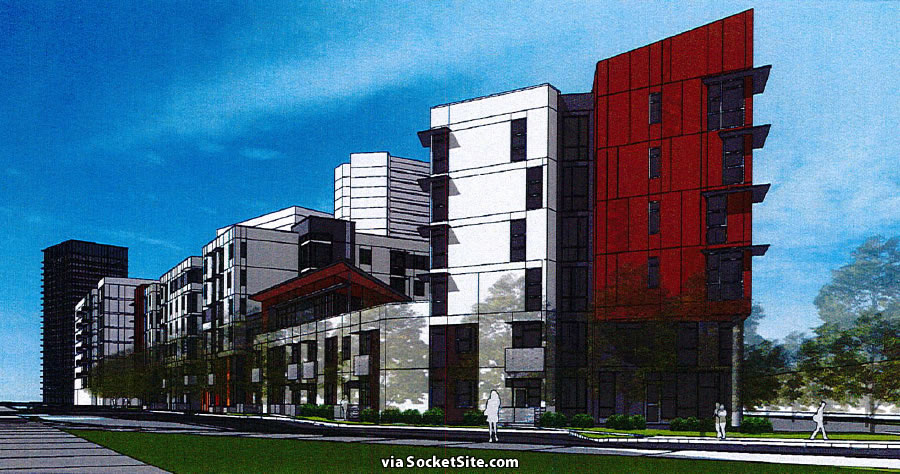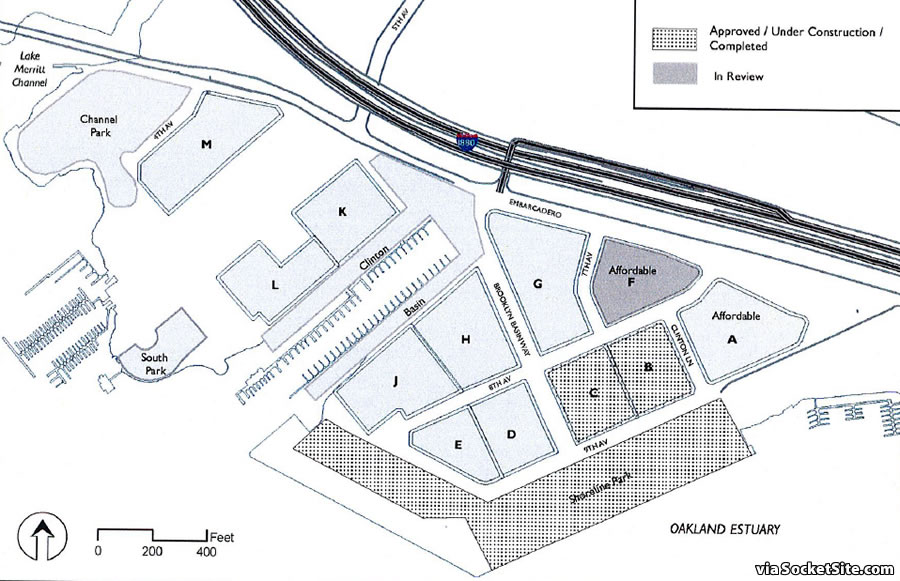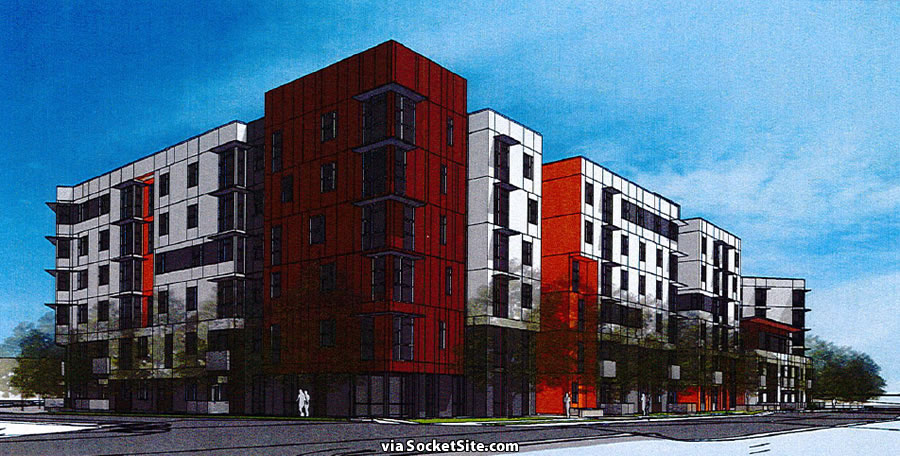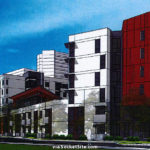With the first building of the massive Brooklyn Basin project – a 64-acre East Bay development which will yield up to 3,100 units of housing, 200,000 square feet of commercial/retail space and 30 acres of open space along Oakland’s waterfront – under construction and plans for the second building having been approved, the prodesign for the first of Brooklyn Basin’s two below market rate (“affordable”) buildings will be presented to the city’s Design Review Committee this week.
And as designed by HKIT Architects for MidPen Housing, the 86-foot-tall building to rise on Brooklyn Basin’s Parcel F (a triangular parcel bordered by Embarcadero, 7th and 8th Avenues) will yield 211 dwelling units and a garage for 192 cars.
Designed as two attached structures which could be constructed in two phases, phase one includes 101 units designated for families, with a mix of one to three bedrooms apiece. Phase two includes 110 units designated for seniors, with mostly one-bedrooms and a few twos.





I don’t know why Oakland is allowing this huge project in a transportation desert. These people will be obliged to drive everywhere. That’s not going to help traffic, and it certainly isn’t in accordance with state and local greenhouse gas emissions goals. It’s a 1.2-mile walk (through a homeless tent city) to BART, and a half-mile walk to the nearest bus stop, will only two buses per hour. The alleged bike bridge over I-880 isn’t going to help much. Meh.
They’re allowing it because the Bay Area has a terrible housing shortage.
They are planning on adding bus routes. If we only built around BART nothing would get done.
What, exactly, are these plans? I can’t find any. The transportation demand management doc for this project only vaguely suggests that the free Broadway Shuttle could be extended to 9th, but this would be a very poor service since it runs infrequently and serves 12th St, not Lake Merritt. That “plan” also discusses the AC Transit 1 line, which is irrelevant because that’s undergoing a billion-dollar BRT upgrade down International Blvd. It also waves its hands about a possible developer-provided weekday-peak-hours-only shuttle to Lake Merritt BART.
The thing these non-plans have in common is they only serve work commuters. There is no plan to serve people who might want to just move from one place to another for non-work reasons. There is no discussion of how children will get from Brooklyn Basin to schools, all of which are on the other side of I-880.
you are essentially correct. There IS a requirement that the developer support a shuttle, but it won’t be adequate, and this development is (essentially) an island. It is likely that AC will begin servicing this area by their own volition (and with the city’s encouragement), and the City will begin to make improvements too for walking/biking access. But the “plan” for Brooklyn Basin was hurried through without fixing these issues FIRST.
It’s an issue, and is perhaps symptomatic of where the City was then (in the depths of the recession) versus where it is now. In time, it will be fixed. And, for the record, it is .7 miles to this housing site from Lake Merritt. That is more than the typical 1/2 mile walk shed, but not hugely so.
It’s three quarters of a mile in a straight line from Brooklyn Basin to Lake Merritt BART, but these are not houses for birds. It is over a mile by foot from A to B.
apologies JWB you are correct. I was googling from the wrong part of Brooklyn Basin.
It will be .4 miles to the 96 bus that serves Lake Merritt BART, but that is way too far to walk to a bus that only operates twice hourly during off peak times. There will need to be transit serving the development – there never was because there has been essentially nothing there.
People will drive. Later, they will have transit options but now they will drive.
Is that worse than not building low income housing?
Exactly. Historically, transportation has always come after housing, here and everywhere else. There’s never enough political will to build transit until enough people are already inconvenienced by the lack of mobility options. Wish it were otherwise, but that’s human nature.
“Exactly. Historically, transportation has always come after housing, here and everywhere else”
In all times and places this is not true at all.
“Here and everywhere else” lol no. Not everyone is as stupid as us. Look at the new Seestadt Aspern neighborhood of Vienna. First thing they did was punch in a huge station on a high speed rail line. Then they started piling on the housing. The sensible actions of a “command economy” that someone tried to disparage downthread.
They will add additional bus routes when there is a demand; and btw the Broadway shuttle is actually pretty great. Maybe by then everyone will commute on Ford bikes anyway.
This would be a great bike share location, and I expect we will see one as a part of the first project completion.
Those bikes are so stupid.
Right, because they can’t add bus lines or alter current routes.
If Oakland (or anyone else) only allowed development in a “perfect” location we would never get new housing.
Couldn’t we at least *start* with the “perfect” locations? There are numerous empty and underused properties within 1/4 mile of BART stations.
No. We cannot.
We do not live in the perfect world. This project is designed, funded, and starting approvals. Should we delay housing for hundreds of low income people because somewhere in the Bay Area may be a better location? These people need housing now.
So all affordable housing in the Bay Area must be located within 1/4 mile of a BART station? That leaves about 8.6 square miles of “perfect” area in the entire bay area.
We always have these discussions about traffic and cars, but they are always independent of housing discussions.
As a result, we never suggest ideas like a BART station has 100-200 low income housing units that stipulate that residents not have a vehicle registered to qualify. We can’t find housing for everyone, but I’m sure we could find 100 low income residents that don’t have a car anyway. Sadly, this never because while don’t necessarily do 1-size-fits all, we are only willing to reduce number of parking spaces from 90% of units to 50%.
8.6 square miles is enough space to build more than a quarter million dwellings, at the barely-urban density of 50 dwelling units per acre. It is enough room to completely solve the region’s housing crisis, considering that ABAG thinks we only need 180000 new units by 2022.
Pull out your checkbook and purchase said sites. Then pay for all the development costs. Put your money where your mouth is.
Exactly, if those 8.6 square miles were completely undeveloped and owned by someone dying to give it away it would be enough space to build a ton of housing.
I am sure the development community has just ignored those “perfect” locations, particularly the folks who work in acquisitions for development companies who get paid to know about every developable parcel in a market. I am sure you have identified the “perfect” spots on google maps, but the person who makes their living by specifically identifying said “perfect” locations are ignoring them. In other words, the sites you note as “perfect” are either (1) not for sale; (2) already in the planning process; (3) not zoned for residential development; (4) have physical constraints that preclude development of residential units: (5) can’t support an adequate number of units to cover development costs; (6) are dirty dirt; etc. etc. I know, this development thing is hard, isn’t it?. A lot more to it than google maps and message boards.
Your free market idealism is cute but not supported by facts. Many parcels are un- or under-developed simply because their owners are just holding out for more money. There’s an empty lot less than 100 meters from MacArthur BART that someone bought for $100k, held for a few months, and then put it right back on the market for a million. These are not sitting vacant because “this development thing is hard” but because urban real estate in the Bay Area is a lottery, and because out tax code doesn’t properly incentivize development. If we had a proper highest-and-best-use taxation our housing crisis would probably already be behind us.
Yes, centralized planning always works so much better, and everybody on this site is always ready to back up the decisions that are made by the planning department.
Speculation is real estate, tulip bulbs, Tickle me Elmos and what not hurts the overall economy, but the damage it less than what you get from a command economy IMO. And until that empty lot is resold, you haven’t proved a point. How much is the lot worth if it isn’t resold and the owner just gets to keep it clean and pay property tax?
We can argue about the benefits of the free market forever (hint: it’s not going away).
In the meantime, we have the opportunity yo provide housing for hundreds of low income people who don’t give a damn about the theoretical argument but who would like a safe place for their kids to sleep.
If a parcel is not for sale or the owner is holding it out for a price that doesn’t allow a developer to underwrite the deal because the land basis is too high, means such parcel is not a “perfect” location for development and means it’s not developable by definition.
A 1.2 mile walk to BART is really that horrible?
It’s much further than most people are willing to walk to transportation. A half-mile radius is considered the maximum that people will walk to a frequent, high-speed service like BART. Nobody would walk that far for bus service; that outside radius for bus service is 1/4 of a mile.
People will drive.
That’s not the end of the world.
I beg to differ 😉
I’d argue that giving low income families a stable place to live overrides just about every other argument.
All walks are not created equal. If you are walking through suburban office parks or under a freeway and past homeless encampments a few blocks may be too much for most people
I wouldn’t want my wife to make that walk in the daytime, let alone at night. The suggestion boggles the mind.
Wow, these are really ugly. Why do people keep designing buildings even they wouldn’t choose to live in?
I bet the low income families struggling with housing costs will find this building to look just fine.
Compare to 90% of the “middle class” tract housing built in the United States over the past forty years, this is absolutely fine.
So now baristas and part timers can jump ahead of teachers and other middle class professionals who worked hard for their credentials and got pushed out of the Bay Area.
seriously wtf are you talking about?
Some of these affordable housing units have income limits that are below that of a couple working full time at minimum wage. We are providing incentives for mediocrity.
Then there are all the scammers, like the mother of an acquaintance. She is quite well off, but she wants to be closer to her grandkids, so she is getting herself a nice little unit in an SF affordable housing development. Because she easily qualifies based on the lame rules.
Hmmm.you’re right. They are pegged for Very Low ($41,750 family of 2) and Low ($64,350), while full time work for 2 at the current min wage would be $53,497.
Yeah, but there are a LOT of single mothers in SF. About 20% of all SF births are to unwed women (70% of black births and 1/3 of Latino births). They do not earn $64,000 or even $41,000. And, of course, for a variety of reasons, there are a lot of other low earners (disability, no education, etc.). There is always going to be a finite amount of subsidized housing. You could, I suppose, say “screw ’em” to those who don’t/can’t earn $60,000-plus and instead provide subsidized housing to those who earn more. Anger by the have-little at the have-none is pretty popular these days.
I don’t say screw em, I say there is plenty of affordable housing, in Stockton or Ohio. I want to drive a BMW but I have to settle for Toyota. My friend wants to live in Oakland but he ended up in Sacramento. I strongly support a social safety net, but how about we start with a bowl of soup for the hungry, not a filet mignon for those who never finished high school. And if you think these housing projects have only a 1% rate of people gaming the system, you are delusional.
I doubt you have spent much time in public housing. It ain’t filet mignon.
I’m not saying there is an easy answer. Just pointing out that a policy of reserving subsidized housing to two-income couples is rather perverse. Single janitors and barristas with children, you can move to Stockton or Ohio. Married teacher or Target sales clerk couples, you get subsidized housing.
We see this all over. Wal-mart clerks are angry at their non-working neighbors who get food stamps. Office workers are angry at their government secretary neighbors who have a pension. Freelancers with an ACA policy are angry at the Uber driver neighbors with medicaid. Now teachers are mad at single parent janitors who qualify for low-income housing.
There is a difference between helping and enabling, and it doesn’t take a genius to figure it out. You can either dole out limited resources through merit or bureaucracy. When it’s done through bureaucracy it’s usually in exchange for something, in this case votes. And yes, I am aware that our system rewards lots of people who don’t deserve it, but again the problem is often that they have obtained some favor with the bureaucracy.
Yeah, but that’s the problem I noted. This is what happens with economic insecurity so prevalent. Everyone thinks they deserve the limited resource benefit more than the guy one or two rungs down the socio-economic ladder. Why should two teachers making $120,000 between them get cheap govt-provided housing but two college professors who worked a little harder and earn $220,000 get nothing? You can’t just enable those slacker teachers . . .
I’m not advocating for teachers to get subsidized housing, I’m advocating for market rate housing, which in turn will drive down entry level home prices for the middle class. Of course that’s all in theory. In reality, our infrastructure can’t handle more housing, the middle class is nowhere close to being able to afford housing here, and building new housing in areas like this will only just drive up prices due to the gentrification factor.
I’m sure there is at least one person scamming the system.
Still, if one scammer and 99 legitimate low income families get housing, I still see that as a ‘win’.